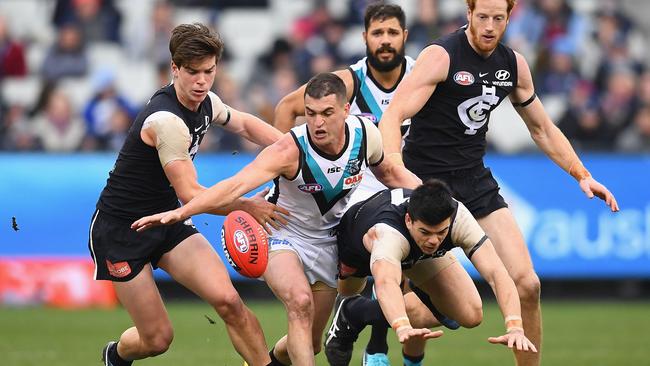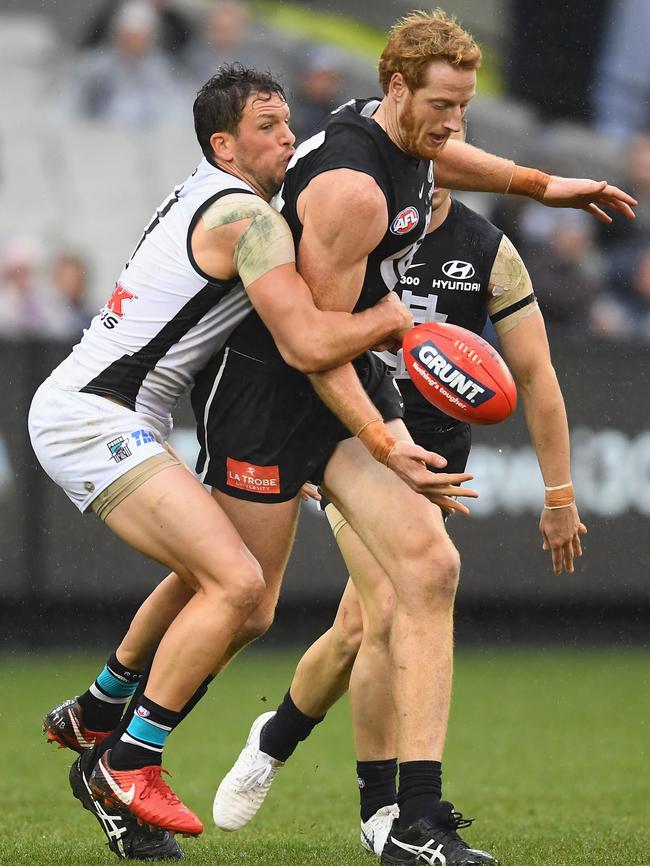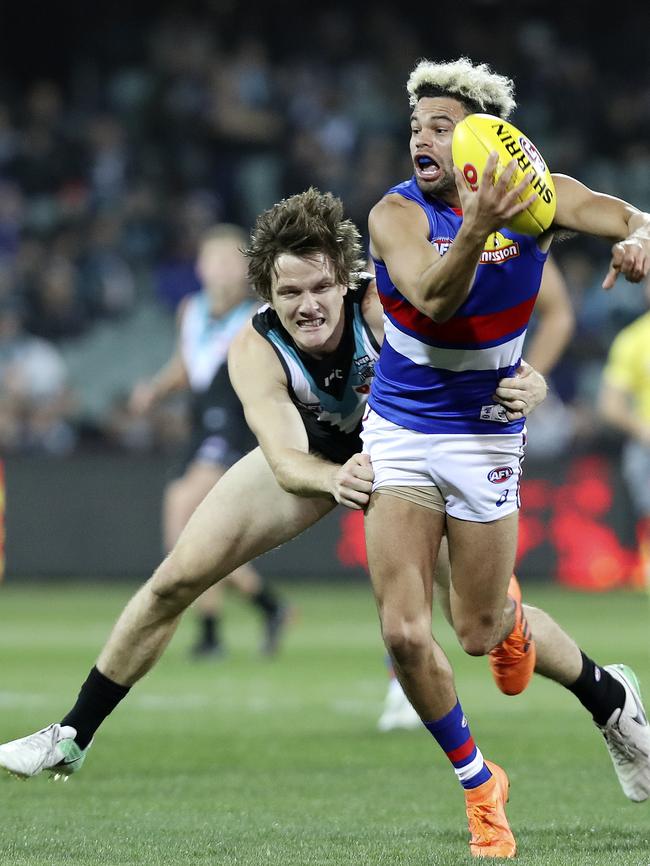Port Adelaide’s rise from pretender to contender has been built on record pressure numbers
ONE of the secrets to Port Adelaide’s mid-season charge has been revealed, with Ken Hinkley’s unit producing pressure numbers never before seen in the AFL.
- Trade HQ: Will Port’s recruiting gamble pay off?
- How Port’s season turned around in Perth
- What are the magic numbers for AFL finals?
- Trengove’s final dream alive
- Bone’s beef: All the way with Port’s DBJ ban
ONE of the secrets to Port Adelaide’s mid-season charge has been revealed, with Ken Hinkley’s team producing pressure numbers never before seen in the AFL.
The Power’s four-game winning streak and run of six victories from its past seven matches has been built on an insatiable appetite to pressure the opposition into turnovers while winning the ball at the coalface and dominating the territory game.
Port’s pressure rating after 15 rounds is 188.4 points — the highest since Champion Data started recording the key statistic six years ago.
The Power, which sits fifth with a 10-4 win-loss record but trails second-placed Collingwood only by percentage, clearly leads the AFL pressure ladder.
It is nearly three points higher than the next-ranked pressure team Hawthorn (185.6).
Much of Port's success since losing badly to West Coast in round seven has been built in attack, with its forward half pressure also being No. 1 in the competition with a rating of 176.9.
“You have seen in the past couple of years that the finalists and eventual premiers, the Bulldogs and Richmond, have been really high with their pressure stats,’’ said in-form Power midfielder Tom Rockliff.

“Richmond was like that when we played it a few weeks ago (round 12) and it was the same with the Melbourne game (round 14).
“We know that you’ve got to put pressure on the ball carrier, first and foremost, and build your defence from there.
“The major stat that most teams look at these days is time in forward half. If you get repeat entries you put the opposition team under the pump.’’
Port has turned up the pressure valve since its stunning Showdown 44 win when former Cat Steven Motlop kicked a goal with 20 seconds left to end a five-game losing streak to archrival Adelaide.
Among the stunning statistical turnarounds are the Power jumping from 18th to third in forward half turnovers created, 18th to second in percentage of scores launched from forward half, 18th to third in forward half turnovers created, and 14th to first in points from forward half turnovers.

Port’s time in forward half differential has risen from -1:57 to +2:48.
The fancy, white-collar football that the Power was at times guilty of playing at times early in the season has been replaced by blue-collar work.
Port’s current game style is more sustainable than the one that flopped for three weeks out of four against Essendon in round four, Geelong in round five and West Coast in round seven.
Not surprisingly, a couple of hard-nuts, powerhouse midfielder Sam Powell-Pepper and unfashionable defender Darcy Byrne-Jones, feature strongly in the pressure stakes for their positions, along with hardworking captain Travis Boak.
Powell-Pepper broke the club record for tackles when he laid a remarkable 17 against Melbourne two weeks ago.


But small forward Jake Neade — currently out of the side and trying to work his way back in via the SANFL — and key off-season recruit Jack Watts also feature highly for pressure.
Neade, whose game is built on applying pressure to opposition defences, ranks elite for a general forward and Watts is elite for a key forward.
Watts’ ranking is surprising given a perceived lack of pressure is understood to be the key reason he has been sent back to the local competition before returning this week.
Champion Data’s complex pressure rating is based on four levels of pressure players can apply — physical (3.75 points), closing (2.25), chasing (1.5) and corralling (1.2).
Each level is worth a certain amount of points, which is worked out by how much harder it is for the opposition to record an effective disposal from that pressure, compared to when they are under no pressure.
Hinkley described his team’s pressure against the Demons — when Port won despite losing inside 50s 68-39 — as “through the roof’’.
“It shows a fair bit of growth because we’ve lost a lot of games like that before,’’ he said.
Watch every match of every round of the 2018 Toyota AFL Premiership Season. SIGN UP NOW >



